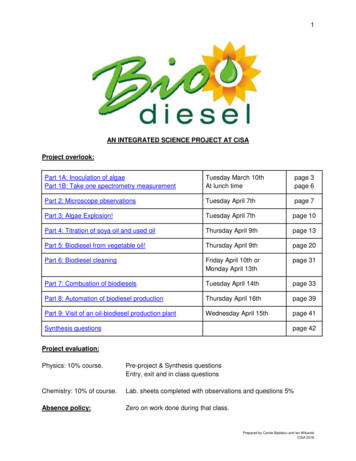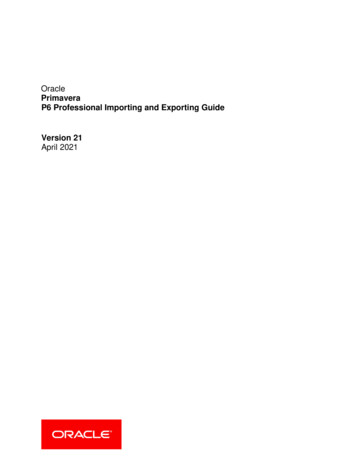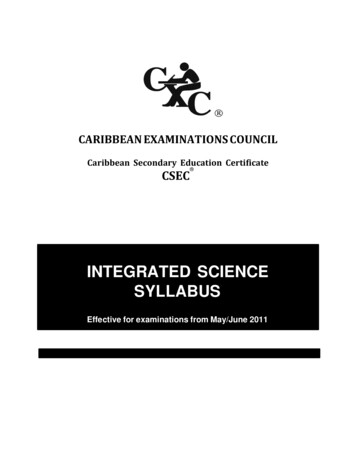
Transcription
1AN INTEGRATED SCIENCE PROJECT AT CiSAProject overlook:Part 1A: Inoculation of algaePart 1B: Take one spectrometry measurementTuesday March 10thAt lunch timepage 3page 6Part 2: Microscope observationsTuesday April 7thpage 7Part 3: Algae Explosion!Tuesday April 7thpage 10Part 4: Titration of soya oil and used oilThursday April 9thpage 13Part 5: Biodiesel from vegetable oil!Thursday April 9thpage 20Part 6: Biodiesel cleaningFriday April 10th orMonday April 13thpage 31Part 7: Combustion of biodieselsTuesday April 14thpage 33Part 8: Automation of biodiesel productionThursday April 16thpage 39Part 9: Visit of an oil-biodiesel production plantWednesday April 15thpage 41Synthesis questionspage 42Project evaluation:Physics: 10% course.Pre-project & Synthesis questionsEntry, exit and in class questionsChemistry: 10% of course.Lab. sheets completed with observations and questions 5%Absence policy:Zero on work done during that class.Prepared by Carole Baddour and Ian WikarskiCISA 2016
2PRE-PROJECT RESEARCH QUESTIONSKeep track of your references1- Explain what is a renewable energy.2- Explain/define what a biofuel is.3- From what plants can we produce oil? Name at least 7 plants.4- What are the main differences between diesel and regular car fuel?5- Do you use cooking oil or frying oil at home? Estimate the volume of vegetableoil used per month in your household. Estimate the volume of oil per year.6- Cooking and frying oils should not be discarded down the sink after usage. Listand explain at least 3 environmental impacts when vegetable oils are released inthe environment.7- Briefly research the Jatropha curcas nut and its usage in Africa. Summarize yourfindings in 5-10 lines.8- Several years ago, alcohol from corn plants began to be mass produced andadded to regular fuels. At first, lobbyists and some governments were promisinga bright future to this type of fuel, that could eventually replace ‘’traditional fuels’’.Time has shown several negative sides (impacts) of using alcohol as a fuel.Research and clearly explain three negative effects.9- Vulgaris algae are grown in our laboratory by exposing them at 16 hours of lightper day under light fluorescent tubes glowing mostly in the red and bluespectrum.a) Research scientific papers online (http://scholar.google.ca/) and provideparameters that could be added in order to INCREASE algae and/or oil growth.Keep track of your references.b) Explain why glycerol and glucose were chosen as good medium growth.Prepared by Carole Baddour and Ian WikarskiCISA 2016
3Part 1A: Inoculation of algaeTeacher: Ms. BaddourTime: 90 or 120 minutesPurpose:To inoculate two species of algae for the biodiesel project.Evaluation:Pre-Lab Assignment Laboratory WorknonenonePost Lab AssignmentnoneMaterial: GlovesGraduated cylinder 100 mlConcentrate Bold’s Basal medium (BBM) (2 Eppendorfs of 1 ml)2 Autoclave Erlenmeyer flasks stirrer3 Serological pipettes (5 ml, 25 ml)Micropipettes (P1000) TipsEthyl Alcohol (70 %)Distilled waterPlastic beaker (waste)Algae strain : Chlorella vulgaris cultureProcedure:1 - Preparation of Bold’s Basal medium (BBM) in an aseptic environment1.1 – Before preparing the BBM solution, you need to clean a portion of yourbench area. This will be your ‘aseptic manipulation zone’.1.1.1 – Clean your ‘aseptic manipulation zone’ with 70 % Ethyl Alcohol.1.1.2 – Gently clean everything that you need to manipulate in your‘aseptic zone’ (micropipette, graduate cylinder, Erlenmeyer) with70% Ethyl Alcohol.1.2 – Preparing Bold’s Basal medium (Final volume 100 mL) from theconcentrate BBM (all manipulations below are done in the ‘aseptic zone’)Prepared by Carole Baddour and Ian WikarskiCISA 2016
41.2.1 – A 1/50 dilution is needed to obtain the final BBM solution.Calculate and record the amount of concentrated BBM & distilledwater needed. Ask Ms Baddour or Ms Otis to validate yourresults.1.2.2 – Watch these tutorials ‘How to use a micropipette’:ow.ly/urBIu (English)ow.ly/urBYq (French)1.2.3 – Make the 100 mL BBM solution. Add the required volume ofdistilled water in the cylinder to 70% of the final required volume.1.2.4 – Pipet the amount of concentrated BBM with P1000 micropipettefrom the Eppendorf. Transfer the concentrated BBM into thedistilled water in your cylinder.1.2.5 – Add the remaining necessary distilled water to top off the volumeto 100 mL.2 – Inoculation of the algae (all manipulations below are done in the ‘asepticzone’)2.1 – Using a 25 ml sterile pipette, transfer 45 mL BBM solution from yourcylinder to a 250 mL Erlenmeyer flask (which has already been sterilized inautoclave).2.2 – Using the same pipette, transfer another 45 mL BBM solution to a second250 mL Erlenmeyer flask (which has already been sterilized in autoclave).2.3 – Identify the Erlenmeyer flask with a tape:First flask: C. Vulgaris, date, your initials2.4 - Using a 5 mL sterile pipette, transfer 5 mL of Algae Chorella Vulgaris straininto the appropriate identified Erlenmeyer flask. (Note: Ask the technician forthe C. Vulgaris culture).2.5 – Cover the mouth each of your Erlenmeyer flasks with aluminium paper.Make sure the aluminium paper is well pressed down.2.6 – Place your Erlenmeyer flasks on a stirring plate under the fluorescentlights in the Physics lab. (Ask Ms Baddour or Ms Otis to show you the righttable).Prepared by Carole Baddour and Ian WikarskiCISA 2016
52.8 – Clean your bench, materials & store everything in your baskets except forthe pipets (garbage).To sign up for absorption measurements at lunch time, sign up here:https://docs.google.com/document/d/1k lKrFbh4z51Qz275u44z3UKTK-DXzd fachxVCB8Zo/edit?usp sharingPrepared by Carole Baddour and Ian WikarskiCISA 2016
6Part 1B: Take one spectrometry measurementTeacher: Ms. OtisTime: 25 minutes at lunch timePurpose: To learn how to use a spectrophometer and provide absorbance results of asolution.To develop micropipettes skills.Evaluation:Points will be awarded to the graph created at the end of the project, only ifmeasurements were taken. Absent zeroInsert measurement in google form here:https://docs.google.com/spreadsheet/ccc?key 0Arue 5GKXYUQdElwTXNvOVB3aV9SQU5XMWNLaVhsN2c&usp sharingFigure 1 : Electromagnetic SpectrumPrepared by Carole Baddour and Ian WikarskiCISA 2016
7Part 2: Microscope observationsTeacher: Mr. WikarskiTime: 90 minutesPurpose: To observe algae cells and locate oil production sites.Evaluation:Pre-Lab.assignmentNoneLaboratory workPost. Lab assignmentTake pictures ofspecimens &answer questionsQuestions to be answered andsubmitted on moodleBackground information:Algae are like plants in the sense that they photosynthesize and are multicellularorganisms. These eukaryotic cells vary in size, but samples are in the order of 2-5micrometers (2X10-6m to 5X10-6m)Microalgae (Chlorella Vulgaris) and yeasts are unicellular organisms. Each individualhas only one cell. Yeasts and microalgae (like plants and algae) are eukaryotic cells.The nuclei of the cells are small dark round spot inside each cell. You must be able tosee vacuoles, transparent white spots inside the cell.Procedure:Today, you will observe fresh and dry algae cells under the microscope and try to locateoil within the cells.Slides available for 4 observations:-Algae : Ulva or FucusYeast : Budding yeast, w.m.Plant (corn) : Corn leaf, c.s.Fresh Microalgae : YOUR own Chlorella Vulgaris1- Choose 3 slides amongst the ones available (1 Algae, 1 Yeast, 1 Plant) andrecord data in chart below.2- Prepare a wet mount of your algae C.Vulgaris :a. Clean the slide with alcohol 95% and a Kimwipe to remove dust.Take, with a transfer pipet, a small volume of your algae culture from yourErlenmeyer and put 1 drop over the methylene blue on your slide.Note : Methylene blue stains on the skin.Prepared by Carole Baddour and Ian WikarskiCISA 2016
8b.c.d.e.Clean the cover slip with a Kimwipe to take remove dust.Add gently the cover slip on the slide with 45o angle. (See picture below).Remove excess liquid with Kimwipe.Observe under the microscope with a 1000X magnification using oil.f. When all the observations are done, clean each objective with lens paper& alcohol 95 %. *** Please, pay attention to clean well the 100X objectivethat had oil immersion. ***g. Take a picture of each observation to include in your chart.h. Complete chart (question 1) below.Prepared by Carole Baddour and Ian WikarskiCISA 2016
9Part 2 Questions:Keep track of your references1- Complete the chart below:YEASTALGAEPLANTMICROALGAENamePicture ordiagramMagnificationBriefdescription(color, size,etc.)Organelle(s)seen2- Plants are already used in the production of biofuels. Research someexamples and list two plants used in North America to produce fuel.3- Briefly explain why algae cells are green. Be sure to explain which colorsfrom the electromagnetic spectrum are essential for algae growth.4- According to your observations, which cell organelle contains lipids? Verifyyour answer by researching information online.5- Briefly research how a fluorescent microscope works. Explain how this typeof microscope would be of great interest for identifying oil in cells.Prepared by Carole Baddour and Ian WikarskiCISA 2016
10Part 3: Algae Explosion!Teachers: Ms. BaddourTime: 120 minutesPurpose: To measure light absorbance of algae cells with the use of aspectrophometer. To extract oil from algae cells.Evaluation:Pre-Lab.assignmentRead backgroundinformation andprocedureLaboratory workPost. Lab assignmentnoneQuestions to be answered andsubmitted on moodleBackground information:Production of biodiesel from algae cells has a promising future. The total yield of oil perhectare from algae cells is more than 10 times the yield production of traditional plantslike soya or canola.Procedure:1- Today, you will measure light absorbance of your own algae cells using aspectrophometer. Light absorbance is done at 685nm.a) Diluted your algae culture Vulgaris in a ratio 1:5 in order to obtain a FINALvolume of 1ml.b) Measure absorbance at 685nm and record results.c) Using the graph, below, calculate how many cells per ml you have in yourdiluted sample.d) Multiply your answer in d) by 5 (dilution factor). Record answer below.2- The second part of today’s laboratory is to remove algae cells from their nutritiveculture, wash them properly to avoid contamination and break the cell wall of thecells to extract oil (faire une lyse cellulaire). Oil extraction is done by ‘’cooking’’the cells in a vapor sterilized oven.a) Extract 50ml of algae culture transfer into 50 ml centrifugation test tube(Rely on centrifugation tube graduation).b) Centrifuge 4800rpm for 5 minutes.c) Remove surfactant and clean with 10 ml distilled water.Prepared by Carole Baddour and Ian WikarskiCISA 2016
11d) Centrifuge again at 4800rpm for 5 minutes.e) Remove surfactant and add 2.5 ml (maximum) of distilled water anddispose in official container.Figure 1: Growing trends for three types of unicellular algae cells.Part 3 Questions:Keep track of your references1- How many microliters of solution did you dilute in water to obtain a final volumeof 1ml? Show calculations below.2- State absorbance value at 685nm.3- Use the figure above to calculate how many cells you have per milliliter ofnutritive culture. Show calculations below. (Do not forget to multiply by 5).4- Why is it necessary to zero the spectrophometer before measurements?Prepared by Carole Baddour and Ian WikarskiCISA 2016
125- The absorbance is done at 685nm. What color is this?6- Why is the absorbance done at 685nm? Explain.7- Provide a free body diagram of forces acting on an algae cell when insidecentrifuge.8- What is the centripetal acceleration on an algae cell located at the bottom of atest tube when inside the centrifuge? radius 10.3cm9- Our centrifuge at CiSA rotates up to 6000rpm. State this frequency in Hertz.10- The word centrifuge comes from the centrifugal force. What is the centrifugalforce? Compare it to centripetal force studied in class.11- Modern ultracentrifuges have a frequency of about 60000Hz. If a red blood cell(mass 0.01g) is at the bottom of a test tube inside a centrifuge with a radius of 15cm, find the centripetal force exerted on the red blood cell.Prepared by Carole Baddour and Ian WikarskiCISA 2016
13Part 4: Titration of soybean oil and used oilTeachers: Ms. BaddourTime: 90 minutes (if 120 minutes, better)Purpose:The purpose of this experiment is determine the quantity of free fatty acids (FFA) in twosamples of oil (virgin soybean oil and used oil) by titration with KOH. This information isneeded in order to calculate how much catalyst is needed for the conversion of theseoils into biodiesel.Evaluation:Pre-Lab.assignmentEntry quiz onprocedures thatwill be done todayLaboratory workPost. Lab assignmentGoogle doc. entryQuestions to be answered andsubmitted on moodleIntroductionWhat is a standard solution?A solution prepared using a substance of known high purity, dissolved in a knownvolume of solvent1. Thus, the concentration of a standard solution is accurately knownand is usually expressed as a molarity (mol of solute/L of solution). It is important thatthe mass of solute and the final volume of the solution are measured precisely (massof solute on an electronic balance and volume of solution with a volumetric flask).Note: Usually chemists prepare a stock solution when using standard solutions in thelab. A stock solution is a concentrated solution, which is then diluted to a lowerconcentration for actual use.What is a titration?Titration is a technique commonly used by chemists to determine the concentration of asolution. It involves the slow addition of one solution of known concentration (e.g. astandard solution) to a known volume of another solution of unknown concentration.The solution of known concentration is called the titrant. The addition of the titrant to the1http://goldbook.iupac.org/S05924.htmlPrepared by Carole Baddour and Ian WikarskiCISA 2016
14solution of unknown concentration continues until the reaction reaches neutralization(typically indicated by a change in colour)2. Figure 1 illustrates a typical titration setup.StopcockFigure 1 - Typical Titration Setup3Remember: Burette readings always have 2 decimal places.23http://chemwiki.ucdavis.edu/Analytical Chemistry/Quantitative /deki/files/5184/ new burette.jpgPrepared by Carole Baddour and Ian WikarskiCISA 2016
15Background information:Used oils (ones that have been used once already for cooking) contain free fatty acids(FFA). Recall that all oils are composed of triglycerides and that triglycerides are madeup of 3 fatty acid chains connected to a glycerin backbone. During heating, thetriglycerides break down into diglycerides and FFA, as shown in Figure 1. The more anoil is used, the more the concentration of FFA increases. Used oils can contain up to 15% (m/v4) FFA. The darker the used oil, the higher the FFA content.Figure 1: Formation of free fatty acids (FFA)Why are we concerned about FFA? Because during the transesterification reaction toproduce biodiesel, the FFA react with the catalyst (a strong base: NaOH or KOH) andform soap! (Figure 2). The presence of this soap causes problems during biodieselpurification and it hinders the separation of the biodiesel phase from the glycerin phase.Figure 2: The reaction of FFA with a strong base to form soapThus, the amount of FFA must be determined by titration. Then, the extra amount ofcatalyst (KOH) that will be needed for the conversion of used oil to biodiesel can becalculated. In this way, we will ensure that there is enough available catalyst for thetransesterification reaction.415 % m/v 15 grams of FFA per 100 mL of used oilPrepared by Carole Baddour and Ian WikarskiCISA 2016
16Material IsopropanolKOH stock solution (1 % m/v5)PhenolphthaleinSoybean oilUsed oilUniversal supportBurette support50 mL burette125 mL Erlenmeyer flask x 45 mL transfer pipettes10 ml graduated cylinder100 ml volumetric flaskFunnelGlovesProcedureA) Prepare your titrant Standard KOH solution [0,1% m/v] (Vf 100ml) from a KOHstock solution [1% m/v]1. Dilute the KOH stock solution by a factor6 of 10 by transferring mL of yourstock solution to a clean volumetric flask using a graduate cylinder. Add distilledwater to the appropriate final volume. This new solution is your titrant, label it.B) Titration of a Used & Soybean oil2. Fill the burette with the titrant solution (0.1 % m/v KOH). Record the exactinitial volume of the solution in the burette (Remember: Burette readings alwayshave 2 decimal places).Note : Remove the air bubble, if present, from the bottom of the stopcock bygently tapping on the burette.3. Add 10 mL isopropanol (use a graduated cylinder), 1 mL of used oil (usetransfer pipette), and 2-3 drops of Phenolphthalein to a 125 mL Erlenmeyerflask.Note: Make some up & down with isopropanol in order to dissolve and transferall of the oil from the pipette to the Erlenmeyer.560.1 % m/v 0.1 grams of KOH per 100 mL of waterDilution factor Vnew/VoldPrepared by Carole Baddour and Ian WikarskiCISA 2016
174. Titrate drop by drop and agitate continuously the Erlenmeyer flask until theend point is reached.Note : Titrate by adding the titrant from the burette to the titrated solution in theflask. Do this by opening the tap(stopcock) to deliver a small stream oftitrant to your flask. The indicator will change colour when the titrant hitsthe solution in the flask, however this colour change will disappear oncethe solution is mixed. As you get close to the end point, slowly add thetitrant drop by drop!. The endpoint occurs when a permanent dark pinkcolour is obtained.5. Once the endpoint is reached, record the exact final volume of KOH in theburette.Ref : Image by Valerie Otis6. Repeat steps 1 to 4 for a second trial with the used oil and calculate theaverage volume of KOH used. The results should not vary by more than0.10 mL. Remember to add more titrant solution to the burette beforestarting the next titration and don’t forget to record the initial volume.Note: After your first titration – keep your Erlenmeyer flask nearby to comparewith the remaining titrations.7. Repeat steps 1 to 5 with the soybean oil.8. Completely remove the KOH titrant solution from the burette and put it in theappropriate waste container.At the end only, cleaning: Dispose the solution titrated in the appropriate waste container.Rinse volumetric flask with water & let it dry.Wash the Erlenmeyer flasks with water & soap. Use a brush to helpdissolve the oil.Place the glassware upside down in the drying rack.Prepared by Carole Baddour and Ian WikarskiCISA 2014
18Name:Part 4 Questions:1. Record your titration data in the following table.Used oilInitialKOHvolume(mL)FinalKOHvolume(mL)Soybean oilVolumeof olumeof KOHused(mL)Trial 1Trial 2Average2. Calculate the % FFA in both oils.Used oilSoybean oil% FFACalculationsPrepared by Carole Baddour and Ian WikarskiCISA 2014
193. Calculate the extra KOH that will be needed for the transesterification reactiontomorrow. Remember that 1 mL of oil was usedUsed oilAverage volume of KOH 0.1 % usedduring titrationMass of extra KOH needed per L of oilMass of extra KOH to add to 55 mL ofoilCalculationsPrepared by Carole Baddour and Ian WikarskiCISA 2014
20Part 5: Biodiesel from vegetable oil!Teacher: Mr. Ian WikarskiTime: 120 minutesPurpose:The purpose of this experiment is to produce biodiesel from soybean oil. You willperform the transesterification reaction and use stoichiometry to determine the percentyield of the reaction. The percent conversion of used oils and virgin oils will becompared.Evaluation:Pre-Lab.assignmentEntry quiz onprocedures thatwill be done todayLaboratory workPost. Lab assignmentnoneQuestions to be answered andsubmitted on moodleBackground information:The transesterification reaction is as follows:Prepared by Carole Baddour and Ian WikarskiCISA 2014
21Common Fatty Acids:Biodiesel is a fatty acid methyl ester (FAME) the most abundant FAME in biodiesel islinolenic acid methyl ester:Prepared by Carole Baddour and Ian WikarskiCISA 2014
22Material 55 mL of soybean oil and 55 mLof used oil 40 mL methanol x 2 KOH pellets 100 mL beaker x 2 125 mL Erlenmeyer flask x 2 100 mL graduated cylinder x 2 25 ml graduated cylinder x 1 thermometeruniversal standthermometer clampheating platetransfer pipettesmagnetic stir barsTimerSetup(a)(b)(c)Figure 1 (a)-(c): Setup for transesterificationProcedure:1 – Prepare your caustic methanol solutions (one to be used for soybean oil and one tobe used for the used oil).2.1 Label two 100 mL beakers: “Caustic methanol for soybean oil” and “Causticmethanol for used oil”.2.2 In the first beaker (for soybean oil): Weigh 1.4 g of KOH. Dissolve theKOH in 40 mL of methanol (measure with 50 ml cylinder) in a 100 mLbeaker using a magnetic stir bar. Wait until the KOH dissolves completely(this may take up 10 minutes).2.3 In the second beaker (for used oil): Weigh 1.4 g 0.0605 g 1.4605 g ofKOH. (The extra KOH amount is determined from the titration results fromPrepared by Carole Baddour and Ian WikarskiCISA 2014
23yesterday). Dissolve the KOH in 40 mL of methanol in a 100 mL beakerusing a magnetic stir bar. Wait until the KOH dissolves completely (this maytake up 10 minutes).2 - Prepare your setup as shown in Figure 1.3 – The transesterification reaction:3.1 Measure 55 mL of soybean oil using a 50 ml graduated cylinder. Transferthe oil into the Erlenmeyer flask and add a magnetic stir bar. Make sure yourflask is stabilized and well supported by clamping it to the universal stand(see setup image).3.2 Add hot water from the tap to the water bath container and gently heatusing the heating plate.3.3 Using the thermometer clamp, fix the thermometer in order to be able todetermine the water bath temperature.3.4 Start the agitation on the heat/stir plate. Adjust it such that you form a littlewhirlpool in the oil, without causing any splashing.3.5 Heat until the temperature of the water bath reaches 50 oC, then turn off theheating.3.6 Add 14 mL of caustic methanol to the Erlenmeyer flask using a 25 mlgraduated cylinder.3.7 Maintain the temperature of the water bath between 45 and 55 oC for 20minutes. To do this, wait until the temperature decreases to 45 oC beforeturning on the heating again.Note: The temperature must not exceed 55 oC.3.8 After 20 minutes, the reaction is done. Stop the agitation and turn off theheating plate.3.9 Remove the Erlenmeyer flask from the hot water bath and leave it on the labbench to cool down for about 10 minutes, so that it reaches roomtemperature.3.10 Meanwhile, repeat steps 3.1 to 3.9 with 55 mL of used oil. Remember touse the caustic methanol that was prepared for the used oil.3.11. Transfer in 150ml beakers. Cover them with aluminum foil. Label each withyour initials.Prepared by Carole Baddour and Ian WikarskiCISA 2015
24Figure 2: Erlenmeyer flask with two phases (upper: biodiesel, lower: glycerin). Image by Ian WikarskiWaste Disposal Instructions: Dispose of caustic methanol in the appropriate containerunder the fumehood.Cleaning:1. Graduated cylinders: Clean every cylinder. If it contains oil, use soap and washthoroughly with the brush.2. Beakers and Erlenmeyer flasks: Wash with water & soap.3. Drying: Place the glassware upside down in the basket to let them dry.Prepared by Carole Baddour and Ian WikarskiCISA 2015
25Name:Part 5 Questions:Keep track of your referencesBackground Questions1. Fill in the following table to indicate the stoichiometric coefficients of thetransesterification reaction performed today.REACTANTSPRODUCTSSoybean oil(triglyceride)MethanolAB Biodiesel(fatty acid methyl esters or FAME)GlycerinCD2. In this lab, we produce a biodiesel from soybean oil at the experimental scale via thetransesterification reaction. Would this reaction be doable with other types of oils?Briefly explain.3. What factors could influence the speed of the transesterification reaction performedtoday with soybean oil?Prepared by Carole Baddour and Ian WikarskiCISA 2015
26Observations4. Complete the table belowDataValuesVolume of soybean oil used (mL)Volume of methanol used (mL)Reaction time (minutes)Temperature of the water bath (oC)Volume of biodiesel collected (mL)The following information will be useful to answer the next few questions.Soybean oilMethanolBiodieselGlycerinMolar Boiling point(oC)25765348290Synthesis Questions5. Using the volumes and experimental information, determine the mass and number ofmoles of the two reactants. Show your calculations below and enter your values into thetable provided.ReactantsVolume (mL)Mass (g)MolesSoybean oilMethanolCalculations:Prepared by Carole Baddour and Ian WikarskiCISA 2015
276. Fill in the following table and show your calculations below. The experimental ratiocorresponds to the number of moles of methanol in the solution for every 1 mole ofsoybean oil present.ReactantsSoybean oilStoichiometriccoefficient fromthe equationExperimentalnumber of molesExperimental ratio1MethanolCalculations:Does the quantity of reactants used agree with the stoichiometric coefficients from thebalanced equation? Explain briefly.7. Recall that we used a caustic methanol solution today (methanol containing a smallamount of KOH, a strong base). The KOH acts as a catalyst. Explain the role of acatalyst and its impact on the reaction.Prepared by Carole Baddour and Ian WikarskiCISA 2015
288. Why is it important to maintain the temperature of the mixture between 45 and 55 oCduring the reaction?9. What property of the two products (biodiesel and glycerin) lets us deduce that the topphase is the biodiesel?10. Calculate the theoretical masses and volumes of biodiesel and glycerin thatshould have been obtained based on stoichiometry. Use the number of moles of thelimiting reactant (soybean oil) for your calculations and consider that methanol is inexcess.Soybean r of molesMass (g)Volume (mL)Calculations:Prepared by Carole Baddour and Ian WikarskiCISA 2015
2911. Use your experimental volumes and theoretical volumes to help you answer thefollowing questions:a) Calculate the percent yield of biodiesel. Remember: percent yield experimentalvolume / theoretical volume x 100DataValuesExperimental volume of biodieselproduced (mL)Refer to Question 4Theoretical volume of biodiesel (mL)Refer to Question 10% yieldb) Knowing that the yield of this reaction should be around 98 %, how does your yielddetermined above compare? Discuss briefly.12. Calculate the percent conversion of the soybean oil and used oil and summarize inthe table below.Volume of oil used (mL)Soybean oilUsed oil5555Volume of biodiesel produced (mL)% conversion (Vbiodiesel/Voil) * 100Prepared by Carole Baddour and Ian WikarskiCISA 2015
3013. How does the percent conversion of the used oil compare to the virgin soybean oil?Explain.14. Explain briefly why converting used oils to biodiesel is problematic compared tovirgin oils. How can you overcome this problematic?Prepared by Carole Baddour and Ian WikarskiCISA 2015
31Part 6: Biodiesel cleaningTeacher: Mr. WikarskiTime: 60 minutesPurpose: To clean the produced biodiesel from free fatty acids andmethanol and create a true acceptable commercial fuel.Evaluation:Pre-Lab.assignmentnoneLaboratory workPost. Lab assignmentnoneN/ABackground information:Biodiesels produced from used oils contain free fatty acids, glycerol, methanol residuesand soap -which are byproducts of the titration process-. To clean your biodiesel fromthese impurities, water will be used. This process is widely used in the industry andwashing accurately the biodiesel will make a truly acceptable commercial fuel.Procedure:The following steps must be done for each biodiesel produced in step 5 (from soya andfrom used oils). You can do the steps at the same time, but use different containers.1- Get your 2 erlenmeyers containing biodiesel from Part 5 lab.2- Transfer the biodiesel (upper phase – refer to Figure 2) by decanting to a 100mL graduated cylinder. Complete the remaining transfer using a transfer pipette.Make sure not to transfer any glycerol to the graduated cylinder!3- Determine the exact volume of the biodiesel collected. Record your volume inthe observation sheet.4- Transfer the biodiesel into a cooking jar (pot Masson) : 1 jar for soya oil; 1 jar forused oil (Identified the jars : type oil, initials, date).Note : You can combine your biodiesel with another team to reduce the amountof jars used.5- Add 20% of volume of tap water to the biodiesel.For example, add 20ml of water to 100ml of biodiesel.6- Add the lid to the jar and shake vigorously for 1 minute. Turn the jar upsidedown several times.Prepared by Carole Baddour and Ian WikarskiCISA 2015
327- Wait 5 minutes and note observations.8- Repeat steps 1 to 4 with the other biodiesel.9- Wait at least 24 hours to record final observations (done next class).Prepared by Carole Baddour and Ian WikarskiCISA 2015
33Part 7: Combustion of biodieselsTeacher: Mr. WikarskiTime: A solid 120 minutes (65 minutes of theory 55 minutes of laboratory)Purpose: To verify the energy content of biodiesel fuels and compare it toregular fuels.Evaluation:Pre-Lab.assignmentNoneLaboratory workPost. Lab assignmentFill out googledocumentQuestions to be answered andsubmitted on moodleBackground information:Renewables biofuels offer a promising hope in the reduction of production of global warmingmolecules (methane, carbon dioxide, etc.). In the past years, the federal government hasimposed new regulations in fuel composition. Table 1 summarizes some regulations.Table 1 : New regulations on commercial fuelsType of fuelContent requiredType of biofuelDate of regulati
Production of biodiesel from algae cells has a promising future. The total yield of oil per hectare from algae cells is more than 10 times the yield production of traditional plants like soya or canola. Procedure: 1- Today, you will measure light absorbance of your own algae cells using a spectrophometer.











